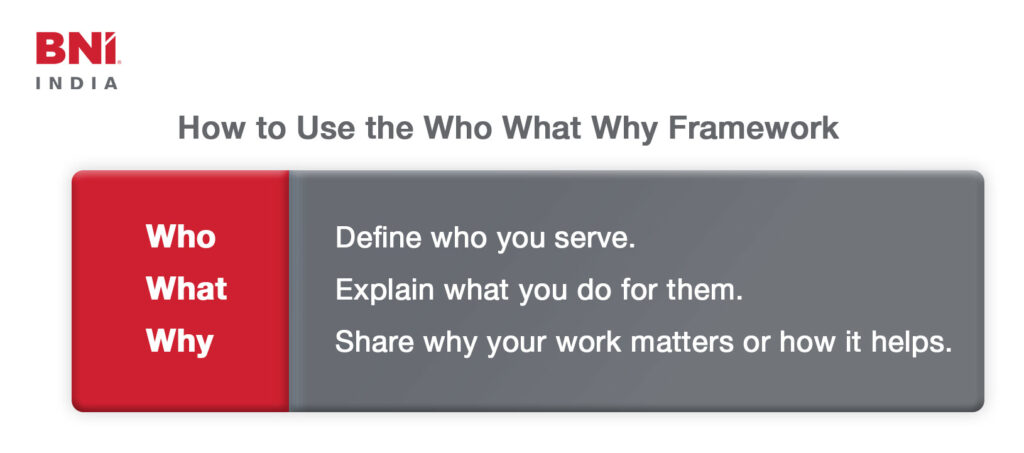You’re at a meeting, a coffee catch-up, or a networking event, and someone says, “You should meet this person; they might be useful for your business.”
It sounds promising, right? But more often than not, that “simple introduction” leads to a polite chat, a few exchanged cards, and silence thereafter.
While introductions by themselves don’t grow businesses, what does is conversations that spark trust, clarity, and collaboration. And since every introduction is a first impression it’s worth making it count.
In this blog let’s walk through how to turn those introductions into meaningful referral opportunities with purpose.
1. Start with Clarity: Define What Makes a Good Referral
Before you can turn introductions into opportunities, you need to know exactly what you’re looking for. Remember that your network can’t refer you effectively if your ask is vague.
Ask yourself three questions:
- Who is my ideal client?
- What problem do I help them solve?
- What does a successful outcome look like?
For example, instead of saying:
“I work with small businesses.”
Try:
“I help family-run retail businesses that want to increase their in-store and online footfall.”
See the difference? The second one paints a picture. It helps your network identify specific people who fit your description and that’s when introductions start turning into referrals.
2. Use the “Who, What, Why” Framework in Conversations
Here’s a simple yet powerful framework to make your introductions more purposeful:

For example:
“I work with architects (who) who want to save time on their design approvals (what). I help them by streamlining the documentation and compliance process, so projects move faster (why).”
Now imagine someone in your network meeting an architect who constantly complains about delays; you’ll instantly pop into their mind.
3. Make Introductions Easy for Others
The best networkers don’t wait for people to figure out how to refer them. Instead, they equip their network to do it right.
You can do this by creating a short “referral-ready” message or kit that your partners can share when introducing you. It can include:
- A short description of what you do.
- The kind of client you’re looking for.
- One quick success story that builds credibility.
For instance, instead of someone saying, “I’ll connect you with Raj, he does digital marketing,” they can say:
“You should meet Raj. He helped one of my clients increase their sales by 40% through targeted online campaigns. He’s great at helping small businesses go digital efficiently.”
That’s how you transform a regular introduction into a warm, trustworthy referral.
4. Use Curiosity to Build Conversations
Introductions don’t always lead to instant referrals and that’s okay. Sometimes, it’s about planting the seed for future opportunities.
The best way to do that? Ask questions that invite stories, not yes-or-no answers.
Try asking things like:
“What inspired you to start your business?”
“What kind of clients or projects excite you the most right now?”
“What’s one challenge you’ve been trying to solve recently?”
When people share stories, they reveal needs, frustrations, and goals which can turn an introduction into a business opportunity.
5. Share Success Stories Naturally
Stories stick. Facts fade.
When you meet someone through an introduction, share short, real examples that show how you’ve helped others. Keep it authentic and conversational, like you’re chatting with a friend over coffee.
For instance:
“One of my recent clients had the same challenge of struggling to get consistent leads. We made a few changes in their referral approach, and they saw a steady increase in business within three months.”
Stories build credibility without feeling like a sales pitch. They make people remember you as a problem solver, not just a service provider.
6. Follow Up, Don’t Fade Away
Introductions lose their value if they’re not followed up. Always send a short thank-you message to the person who made the introduction, and a warm note to the new contact.
Example:
“Thanks for connecting! I really enjoyed our chat and learning about your work. Let’s stay in touch. I’d love to explore how we can support each other.”
A simple, genuine follow-up keeps the relationship alive and shows you value their time — both key elements of BNI’s Givers Gain® philosophy.
7. Keep the Circle Complete
Here’s something many forget! When an introduction turns into business, always remember to close the loop.
Tell the person who connected you and how it went.
That small gesture builds immense trust. It lets your network know their referrals make a real impact and encourages them to keep referring you. Gratitude fuels future opportunities.
8. The BNI Way
BNI creates the perfect environment to practice and master this art. Weekly meetings, structured presentations, and feedback loops help you refine how you talk about your business. Over time, members learn how to articulate their value with precision, making it easier for others to refer them confidently.
Turning introductions into referrals isn’t about luck. When you bring Clarity, Consistency, and Connections together, your business growth becomes Steady, Sustainable, and Scalable.
FAQs
1. How do I know if an introduction can turn into a referral?
If the person shows genuine interest in your work or shares challenges your services can solve, that’s a potential referral opportunity.
2. How specific should I be when describing my ideal client?
Be as specific as possible because the more details you give, the easier it is for others to connect you to the right people.
3. How soon should I follow up after an introduction?
Ideally within 24–48 hours. It shows enthusiasm and professionalism.
4. Should I always expect business from every introduction?
No. Sometimes an introduction leads to collaboration, learning, or a future referral, all of which are valuable outcomes.
5. How does BNI help in turning introductions into referrals?
Through its structured referral system, accountability, and weekly visibility. You build trust over time, making every introduction warmer and more meaningful.
